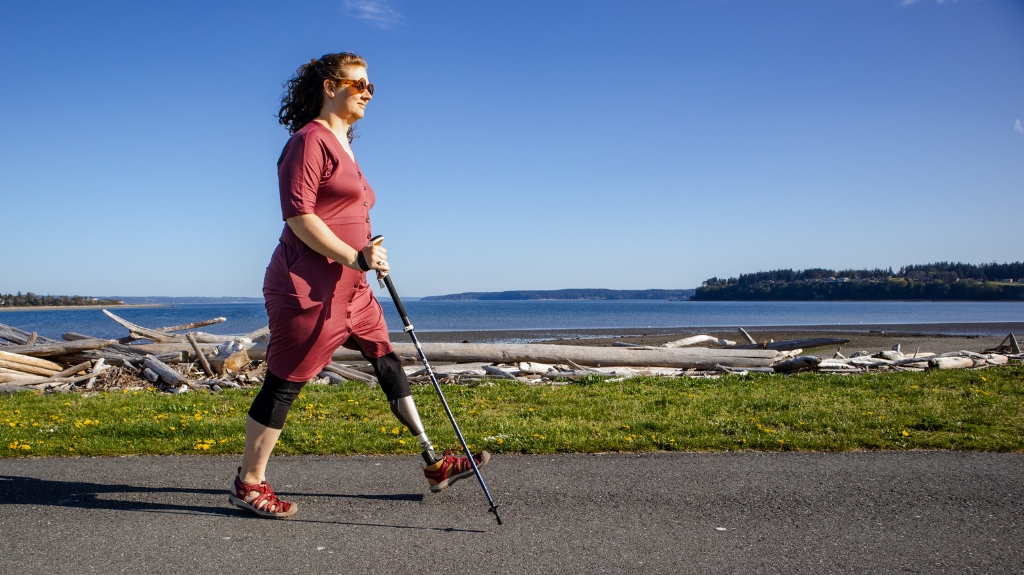
7 Tips When Traveling as an Amputee From an AK Mama

Table of Contents
Guest Blog submitted by Jodie St. Clair from Learners and Makers.
People with disabilities can take the trips they want
No matter how amazing the trip, destination, or experiences, some level of difficulty comes with travel. Navigating travel as a person with a disability can magnify problems. As an amputee who’s had a prosthetic leg since I was 13, I say you can still have the amazing trips you deserve. Read on for Travel Tips for Amputees.
Family and accessible travel: A quick note about our little family
Anthony, Jodie, Connor, and Aster St. Clair: We are the Learners and Makers. Traveling the world full-time since 2022, we empower families and people with mobility disabilities to travel confidently, their way. I’m Jodie, and along with being a mother and business owner, I’m an above-knee amputee who uses a prosthetic leg for my walking mobility.
Mild to cooler temperatures help you prevent overheating and excessive sweating
My walking as an amputee requires more exertion, and I’m prone to sweating. A lot.
In hot, humid weather, or on days when we’re really active, sweat soaks me through.
Plus, I wear a silicone sleeve on my residual limb as part of my prosthetic fit. It can get sweaty in there, which affects everything from how well I move to skin irritation.
We are deliberate about where and when we travel. Dreaming of that trip to Spain, but your vacation time is in July? Consider heading somewhere cooler and saving Spain for fall or spring. By prioritizing milder or cooler times of day and overall seasons, it’s easier for me to enjoy our activities without overheating or sweating excessively.

Be prepared for the weather, and prioritize seasons when it should be easier for you to get around
We typically visit places during times of year when it’s easier for me to get around.
For example, ice and snow are the hardest terrains for me to maneuver with safety and control. Visiting a destination such as Michigan or Wisconsin? You probably won’t find us there in January, but you might in July.
If we’re going somewhere with adverse conditions, we prepare accordingly. That could mean prioritizing certain activities over others, or finding adaptive activities built around my movement needs and challenges.
Terrain will be uneven or challenging, sometimes in unexpected ways
The sidewalks of Ville Nouvelle in Fes, Morocco, are tiled, textured, and even beautiful.
They are also surprisingly slippery.
Dust, grit, and sand form a skim layer that makes these otherwise broad, decently level sidewalks a treacherous challenge for a one-legged girl.
Terrain can be tricky, often in unexpected ways.
For example, in Japan, the public staircases are typically made with a decent pitch and width, but stairs in homes can be steep and narrow.
A trekking pole increases my stability. Whether ruins, stairs, or tricky sidewalks, I take my time and we make sure we’re not in a hurry.
Pack a carry-on medical bag with basic supplies for your mobility equipment
We travel with a long, skinny duffel (which we declare as a free medical item when flying). What your medical bag carries depends on your circumstances, but here’s what’s in mine:
- Pair of folding travel crutches
- Extra prosthetic liner for my residual limb
- Waterproof sock
- Small repair kit (hex wrench, replacement hex screws, loctite, duct tape)
- Collapsible trekking pole (I have another with me)
In a separate backpack, I carry the charger for my prosthesis’s microprocessor knee—along with a letter from my doctor that explains what I need for my mobility and my prosthetic device.
Expect blatant staring
Stares happen whether we’re walking down to a smoothie shop in Da Nang, Vietnam; sampling olives at a medina in Tangier, Morocco; or going up and down the hillside stone steps and ruins of Monte Alban in Mexico.
To be clear, stares also happen in Canada, the USA, Australia, Japan, and European countries. In my experience, they’re usually less blatant.
When kids stare, I encourage them to ask me questions. Sometimes adults want to know the circumstances underlying why I’m an amputee (osteosarcoma, or bone cancer, when I was 13, btw).
Before you travel, understand your comfort level and how you might adapt or respond to staring.
In their stares, I see a learning opportunity. I’m very comfortable in my role of sharing a life experience someone may not be familiar with. I can be an example of someone who enjoys themselves while also having a disability.

Build downtime into your travel activities and sightseeing
Over-scheduling is tiring in general. But if I get overtired from going too fast and furious, activities and sightseeing stop being enjoyable. I can no longer get the good stuff out of why we’re there in the first place.
When building your itinerary, consider what is inflexible and what is flexible. Have a tour with an inflexible starting time and date paired with a day of flexible exploration.
We make sure our activities are padded with rests. That extends to our overall days: If we have a couple of days of activities and sightseeing, we’ll take a day of downtime at our accommodation to rest and recharge.
Don’t over-worry about bad things happening
A bad fall, a prosthetic breaking, demeaning discrimination: Those things are possible during travel.
They are also unlikely.
Some pre-trip contingency planning helps. For example, I keep backup liners with a family member back home who’ll ship one in a heartbeat.
Bad things might happen… but they probably won’t.
My biggest travel problems as an amputee are usually muscle exhaustion or skin irritation..
If something bad happens, odds are you can sort it out.
Take the trip you want to go on
My family and I have been traveling full-time since 2022, but I’ve been an amputee for 30 years.
As with life, so too with any trip or vacation: Problems will come up, but you can deal with them.
So make your itineraries. Don’t sweat the potentials. Go for it, take those trips, and trust that you will have an amazing time.
After all, people with disabilities have to become really good at pivoting and adapting.
Those same skills will make your trips the gratifying, enjoyable experiences that you deserve to have.
A note from Anthony, editor of The World is Accessible:
I’d like to extend a huge thanks to Jodie for submitting this very informative guest post on tips for traveling accessibly as an amputee. I was first introduced to Jodie and her family’s Learners and Makers blog after watching Jodie’s interview on the tabifolk Talks webinar series. Catch Jodie’s episode below:
TWIA
Although all hotel and vacation rental information on this site is thoroughly vetted, we recommend calling ahead to ensure your needs are met.
Newsletter Sign Up:
Thank you!
You have successfully joined our subscriber list.